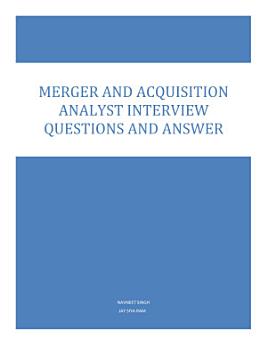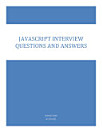Merger and Acquisition Analyst Interview Questions and Answer - English
About this ebook
1. Can you explain the key stages of an M&A deal?
Answer: The key stages of an M&A deal typically include:
Pre-deal Planning: This involves identifying potential targets or buyers, conducting industry and market analysis, and aligning with the company’s strategic goals.
Valuation and Due Diligence: Assess the target company’s financial health through financial statements, understanding risks, and identifying synergies. Valuation methods such as DCF, comparable companies’ analysis, and precedent transactions are commonly used.
Negotiation and Deal Structuring: Both parties agree on the price and structure of the transaction. This may include cash, stock, or a combination of both. Legal aspects and tax implications are also discussed.
Financing: Ensure that financing is secured for the transaction, whether through debt, equity, or a combination.
Closing: Legal agreements are signed, and the deal is officially completed.
Post-merger Integration: This phase focuses on combining the operations, cultures, and systems of the two companies for value creation.
2. How do you value a company in an M&A transaction?
Answer: Valuing a company can be done using several approaches:
Discounted Cash Flow (DCF): This method projects the future cash flows of the company and discounts them back to the present value using an appropriate discount rate (often WACC).
Comparable Company Analysis (Comps): This involves comparing the target company with similar publicly traded companies by using valuation multiples like EV/EBITDA, EV/Revenue, or P/E.
Precedent Transactions Analysis: Analysing past M&A transactions in the same industry to identify valuation multiples that can be applied to the target company.
Asset-Based Valuation: This method looks at the company's assets minus liabilities, often used for distressed companies.
3. What is accretion/dilution analysis, and why is it important in M&A?
Answer: Accretion/dilution analysis evaluates how a merger or acquisition affects the acquiring company’s earnings per share (EPS). It compares the pro forma EPS (after the transaction) to the standalone EPS. If the pro forma EPS increases, the deal is considered accretive; if it decreases, it’s dilutive.
This is important because it helps shareholders understand the potential financial impact of a deal and whether it adds or reduces value from an EPS perspective.
4. What are some common synergies in M&A transactions?
Answer: Synergies are the expected benefits gained from merging or acquiring a company. Common synergies include:
Cost Synergies: Savings from reducing redundant operations, better economies of scale, and optimized supply chains.
Revenue Synergies: Increased revenue from cross-selling products, expanded market reach, or combining sales forces.
Operational Synergies: Improved efficiencies through shared best practices, processes, or technology.
5. Walk me through a DCF analysis.
Answer:
Step 1: Project the target company's free cash flows (FCF) for a certain number of years (usually 5-10 years). FCF is calculated as EBIT (Earnings Before Interest and Taxes) minus taxes, plus depreciation, minus changes in working capital, and capital expenditures.
Step 2: Determine the terminal value at the end of the projection period, either by using the perpetuity growth model or exit multiples.
Step 3: Discount both the projected free cash flows and terminal value to the present using the company’s Weighted Average Cost of Capital (WACC).
Step 4: The sum of the present values of the projected cash flows and the terminal value gives the enterprise value of the company.
6. What are the differences between a stock purchase and an asset purchase?
Answer:
Stock Purchase: The buyer acquires the shares of the target company, assuming all assets and liabilities. The target company continues to operate as a legal entity.
Pros: Simpler for the seller, tax advantages for the buyer (if structured as a tax-free reorganization).
Cons: Buyer assumes all liabilities, including contingent and hidden ones.
Asset Purchase: The buyer selects specific assets and liabilities to acquire, often excluding unwanted liabilities.
Pros: Allows the buyer to avoid acquiring liabilities and allows more flexibility in what’s being purchased.
Cons: May be more complex and time-consuming to execute, potential tax consequences for the seller.
7. What are the risks involved in M&A deals?
Answer: Some risks include:
Integration Risk: Difficulty in combining the two companies’ operations, cultures, or systems.
Overvaluation: Paying too much for the target company due to overestimated synergies or underestimated risks.
Regulatory Risk: Potential issues with antitrust or other regulatory authorities that could block or delay the deal.
Financial Risk: Inadequate financing for the deal or assuming too much debt can negatively impact the acquirer’s financial health.
8. What role does due diligence play in M&A?
Answer: Due diligence is a critical process where the acquiring company reviews the target's financials, operations, legal matters, and market position. It helps identify potential risks, such as unrecorded liabilities, regulatory issues, or operational inefficiencies. Comprehensive due diligence ensures that the buyer makes an informed decision and that any issues discovered can be factored into the negotiation process.
9. How do you approach cultural integration in M&A?
Answer: Cultural integration is essential for a successful merger. Some steps include:
Assessing cultural compatibility early in the process to identify potential conflicts.
Communicating clearly to employees about changes and expectations.
Involving leaders from both companies in integration efforts.
Aligning organizational values and ensuring that talent management strategies, like compensation and benefits, are harmonized.
10. What is the impact of financing structure on a deal?
Answer: The financing structure (debt vs. equity) can significantly affect the deal’s outcome:
Debt Financing: Can magnify returns through leverage but increases financial risk, as debt servicing is mandatory.
Equity Financing: Dilutes existing shareholders but avoids the risk of insolvency. Equity may also be favourable when the acquirer’s stock is highly valued.
General Tips for Answering M&A Interview Questions:
Know your valuation techniques in detail (e.g., DCF, comparable).
Prepare for financial modelling exercises, including constructing accretion/dilution models or DCFs.
Brush up on industry trends in M&A activity, as this shows you're up to date with market dynamics.
Ratings and reviews
- Flag inappropriate








